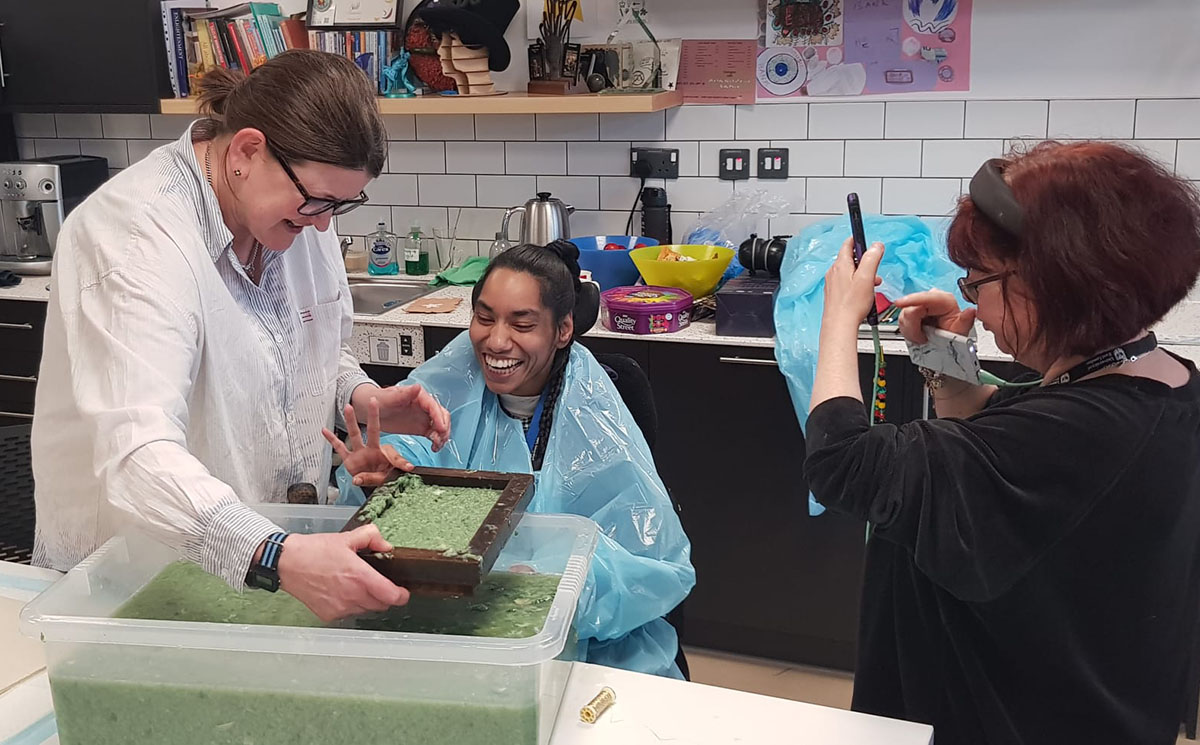The archivists arrive in a pack, laden with enticing boxes. As they begin setting up, I notice Baljit’s rapt attention to their process. Soon, the tables are bedecked with fibre mats, rolling tools, wooden frames, decorative feathers, a grand menagerie of types of paper, egg boxes and curiously, strawberry jelly cubes.
In addition to our usual band of co-researchers, we’re joined by a team of Conservators and materials experts from The National Archives. They’re experimenting with new ways to engage and benefit the community, and in particular, ways to make their work accessible to new audiences. Sensory and tactile engagement are largely unexplored – the conventional means of access comprise reading rooms and exhibits, research counsel, and digital document access.
A hands-on approach challenges the existing look don’t touch mentality associated with museums and archives. It also presents a new avenue of engagement and learning for those less inclined, or excluded, to access the historic value of the archives in the existing ways.
Archvists and Conservators care as much about the physical documents as what’s on them. Paper matters to them. The medium, preservation, and craft of paper can carry as much information as the text printed on it. Today, we’ll be making paper ourselves.
As Victoria, the lead paper maker , begins spinning a tale of the history of paper making, Samantha has selected one of the sheets of raw, pulpy paper to feel and smell. At Rufaro’s suggestion, Victoria passes around examples of real old documents. Each member of the table takes their time to caress the brittle edges, notice the yellowing gradient, and scent the age coming off of the paper.
The history lesson continues, onward from papyrus to the invention of size glue, and the automated press. Samantha gives small noises of amazement. Rufaro chimes in with comments and jokes.
Victoria: “…the machine rolls it flat, and spits it out the other side!”
Rufaro, in response: “So it’s like dough!”
Meanwhile Kiran and Baljit are quiet and focused as Ros’s attention wavers between the speaker and something on her phone. As examples are passed around, I observe expressive and enthusiastic reactions.
Samantha, flexing a wood-pulp page: “Would ya look at that! Aw, I like that.”
Baljit, sniffing the paper mould with a knowing expression: “Wood.”
Rufaro, seeing the moulds: “Mini paper mould… and big paper mould!”

Next, we get to the actual crafting phase. The process involves blending raw fibre and egg boxes into pulp, adding size glue, in this case jelly cubes, then using a paper mould, with a top frame called a deckle to filter out a square portion of pulp, and pressing the water from it.
The raw material for this workshop is a collection of egg boxes and other paper of various kinds. We all do our part to tear it into bits, tossing the results into a cauldron of cold water. Some need help getting started with the manual task of tearing, but with a little help they get into a rhythm. The sound of tearing sheets fills the room, and the rough, fibrous texture of the paper is memorable. Samantha and Rufaro are particularly enthusiastic.
Samantha, talking with the archivists as she works:
“This is the best thing ever!”
“I’ve learned so much today already.”
Rufaro, holding his stack of torn sheets ready to toss in the pot:
“It’s like monopoly money! But… now it’s just gonna be a big blob.”
“I’m going for it, Victoria. I’m doing it!”
Each co-researcher takes a turn mixing the material in the cauldron using a hand blender. Between bouts of mixing, we all get a chance to dip our fingers into the slimy green slurry. The feeling is alien, but strangely satisfying. The vegetable gelatine contained in the strawberry jelly serves as an improvised size glue.

And of course, the finishing touch: pressing the pulp into sheets. It’s a messy process – after plunging the paper mould and deckle into the slurry, you have to drain the excess liquid, wipe off the pulp sticking to the sides, then quickly flip the soggy contents onto an absorbent mat. Everyone has messy hands, and some have been splashed with water, but the atmosphere is playful and joyous.
There’s an opportunity to add decorations before a final hard press that expels water and force the fibres to bind together. I see Rufaro add dyes, Kiran add feathers and a purple star, and others add string, perfume, spices, seeds, or rosemary. The personal touches make the reveal of the final pressed sheet all the more exciting.
Samantha : “I made that!”
Rufaro: “I want to remember this moment.”
Rufaro, at Kiran’s reveal: “It’s a beautiful moment.”
It’s one thing to see and hear about the history of paper — but sharing in the act of creation, using real historical methods, makes it truly real.
That – learning through touch, scent, and creation – is what this workshop is really about. On the surface, today is a trial run for sensory engagement as an outreach method for the archives. But in a broader scope, it’s also a case study for the premise of sensory engagement as a teaching method.
When taught in the right way, people can often learn much more than you might expect. Sensory engagement may prove to be an effective tool for those who aren’t well suited to conventional educational practice. What we learn here informs both pedagogy and policy, and may educate public opinion regarding the real learning ability of those with learning disabilities.
After all, any person’s true potential is boundless. The limits of their capability are, ultimately, defined by the environment they live in and the tools they can access. Today, we’ve made progress towards putting another tool in the accessibility toolbox.
Henry Devenport, CAPA Intern

